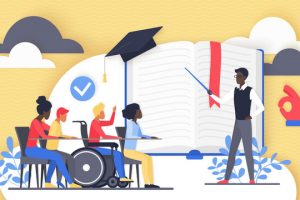The dawn of the digital age has not only revolutionized the way we live and work but has also significantly impacted the field of education. Traditional educational models are evolving rapidly to keep up with technological advancements. This article explores how integrating technology into the American education system is reshaping learning, making it more engaging, efficient, and effective.

Integrating Technology into Classrooms:
In recent years, integrating technology into classrooms has become a paramount focus. Smartboards, tablets, educational apps, and online platforms have become commonplace. The integration of technology enhances interactive learning, allowing students to explore concepts in depth. It also facilitates real-time collaboration, enabling a dynamic and engaging classroom environment.
However, effective integration of technology requires proper training for educators and careful selection of appropriate digital tools. Additionally, schools need to ensure equitable access to technology for all students, bridging the digital divide that could otherwise exacerbate existing educational inequalities.
Personalized Learning:
Personalized learning tailors the educational experience to the unique needs, interests, and abilities of each student. Advanced algorithms and AI enable educators to analyze student performance data, identify learning patterns, and customize learning paths. This individualized approach maximizes student understanding and retention, leading to better academic outcomes.
Moreover, personalized learning cultivates critical thinking, problem-solving, and self-directed learning skills—essential competencies for success in the digital era. It nurtures a sense of ownership in students, empowering them to take control of their learning journey.
Online Learning and Remote Education:
The rise of online learning has significantly expanded educational opportunities. Online courses, virtual classrooms, and remote education have made learning accessible to a broader audience. This mode of learning offers flexibility, allowing students to choose when and where they learn, accommodating diverse schedules and lifestyles.
However, challenges like maintaining student engagement in a virtual environment, ensuring the credibility of online educational resources, and addressing the ‘digital divide’ must be addressed. Effective online education requires robust platforms, interactive content, and an inclusive approach to ensure no student is left behind.
Blended Learning:
Blended learning, a hybrid of traditional classroom instruction and online learning, optimizes the advantages of both methods. Students benefit from face-to-face interactions with teachers and peers while also having access to online resources and assessments. This model offers flexibility, allowing students to learn at their pace and revisit content as needed.
Educators play a crucial role in designing effective blended learning experiences. They need to integrate online content seamlessly, aligning it with classroom instruction to create a cohesive and enriching learning environment.
Future Trends and Predictions:
Looking ahead, the future of education is intriguing and full of potential. Artificial intelligence (AI) is anticipated to revolutionize education. AI-powered systems can analyze vast amounts of data to identify individual learning patterns, enabling highly tailored learning experiences. Virtual reality (VR) and augmented reality (AR) are poised to create immersive educational experiences, enhancing engagement and understanding.
Blockchain technology holds promise for secure academic credentialing and verification. It could streamline the validation of qualifications, ensuring a transparent and trusted credentialing system.
Education in the digital age is an exciting journey, offering endless possibilities to enhance learning. By embracing technological advancements, personalized learning, and staying ahead of future trends, we can transform education to better meet the needs of students. As we continue down this path of innovation, let us strive for an inclusive, accessible, and engaging educational landscape that prepares students for a future defined by constant change and progress.









![Advantages and Disadvantages of Artificial Intelligence [AI]](https://www.newlookeducation.com/wp-content/uploads/2023/09/Advantages_and_Disadvantages_of_artificial_intelligence-300x200.jpg)



![Advantages and Disadvantages of Artificial Intelligence [AI]](https://www.newlookeducation.com/wp-content/uploads/2023/09/Advantages_and_Disadvantages_of_artificial_intelligence-74x55.jpg)

Add Comment